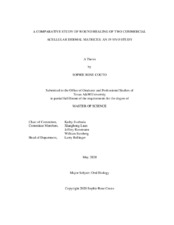| dc.description.abstract | The overall objective of this study was to compare, in vivo, the wound healing and remodeling of two commercial acellular dermal matrices used for gingival augmentation in periodontal surgical procedures. The aims were to evaluate differences in the following at two time points: (1) gingival fibroblast density, (2) de novo collagen formation, (3) matrix degradation, (4) angiogenesis, and (5) males versus females. This was a non-randomized controlled split-mouth study. Envelope flaps were surgically created in the maxillary quadrants of twenty-four Sprague Dawley rats. Each envelope flap was assigned to receive either (1) AlloDerm^TM RTM or (2) OrACELL^TM. Gingival tissue from one mandibular quadrant served as the untreated control. Six male and six female rats were treated for 7- or 21-days. Biopsies were obtained and processed for histologic analysis (H&E, Picrosirius red, Verhoeff’s solution) or RNA analysis (RT-PCR) to compare the expression of type I collagen (Col1a1), fibronectin (Fn-1) and VEGF-A (Vegf-A). A blinded evaluation of soft tissue thickness was performed based on clinical photographs taken before biopsy. There was a greater density of fibroblasts for OrACELL^TM compared to AlloDerm^TM at both 7 and 21 days. There was a greater density of elastin present for AlloDerm^TM compared to OrACELL^TM at 7 days but no differences between groups at 21 days. There was a greater observed soft tissue thickness for OrACELL^TM compared to AlloDerm^TM at 7 days while the opposite was observed at 21 days. There were no differences between test groups in the percentage of birefringent collagen or in the expression of Col1a1, Vegf-A, or Fn-1. At 7 days, there was a significantly greater density of fibroblasts for males in the OrACELL^TM group compared to females. At 21 days, there was a significantly greater expression of Col1a1 for males in the OrACELL^TM group compared to females. Based on the results of this study, early wound healing and remodeling of OrACELL^TM occurred more rapidly than that of AlloDerm^TM. Wound healing of OrACELL^TM was accelerated in male Sprague Dawley rats compared to females. Whether these results have positive or negative clinical implications for soft tissue grafting procedures in humans remains to be determined. | en |


